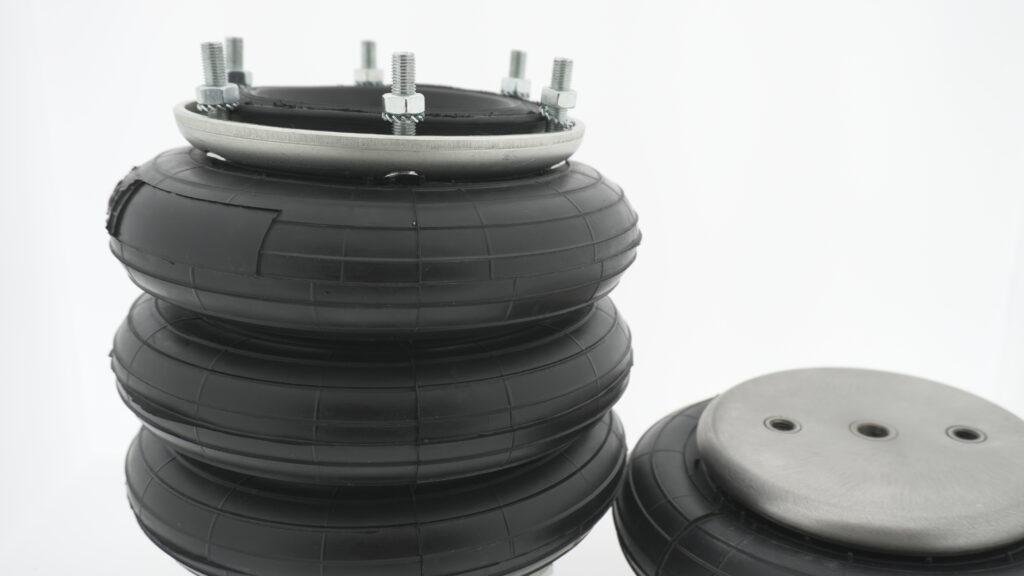
Enhancing renewable energy efficiency with air bellows
In modern renewable energy systems, efficiency and durability are crucial. One highly effective yet underutilized component is air bellows. These flexible elements provide superior vibration isolation, shock absorption, and load balancing. They are essential in wind turbines, solar tracking systems, and industrial power generation units.
Air bellows are made from reinforced elastomer materials, ensuring resilience in extreme environments. They feature multi-ply reinforcement, with options for natural rubber (NR/SBR), chlorobutyl (CIIR), nitrile (NBR), ethylene propylene diene (EPDM), and chloroprene (CR). These elastomers withstand temperatures from -40°C to +115°C, making them suitable for various applications.
The maximum working pressure for standard air bellows is 8 bar, while high-strength versions handle up to 12 bar. Metal components come in galvanized steel, stainless steel (AISI-304), or AISI-316L, ensuring corrosion resistance. Their fatigue life surpasses that of rigid actuators, reducing maintenance costs.

The role of air bellows in wind energy
Wind turbines experience high dynamic loads, especially in fluctuating wind conditions. Mechanical stresses on rotor assemblies, gearboxes, and foundational structures can cause premature wear and reduce efficiency. Air bellows minimize these stresses by providing adaptive damping, reducing the risk of failures and extending operational lifespans.
A single convolution air bellow can absorb up to 450 kN of force, making it suitable for high-load applications. Its low natural frequency of 2.0–4.6 Hz ensures effective vibration isolation. The stroke range varies from 36 mm to 400 mm, offering flexibility in motion control. Height control mechanisms ensure consistent operating positions, even with fluctuating loads.
End closure types include removable bead rings, crimped closures, and bolt-secured plates, providing installation flexibility. Their compact design reduces structural height, optimizing wind turbine nacelle configurations. Air bellows reduce wear on support structures by absorbing oscillations during turbulent conditions, preventing fatigue damage.
Application of air bellows in solar tracking systems
Solar energy systems rely on tracking mechanisms to optimize panel orientation throughout the day. These mechanisms require precision, durability, and resistance to environmental factors. Air bellows ensure smooth operation by providing controlled actuation, improving solar tracker longevity and efficiency.
With tilt capabilities up to 25°, air bellows accommodate lateral misalignment without compromising performance. Their stick-slip-free operation ensures uniform movement, preventing unnecessary energy loss. The wide diameter range (80–950 mm) allows application in various tracking system sizes.
For long-term operation in outdoor environments, air bellows are available with UV-resistant elastomers and corrosion-resistant metal plates. Their fatigue resistance significantly exceeds that of conventional actuators. These features enhance solar system reliability while reducing maintenance frequency and costs.
Their noise-reducing properties improve operational efficiency by minimizing sound emissions, making them ideal for large-scale solar farms. With a service life of over one million cycles, air bellows provide long-term performance in demanding conditions.
Air bellows in hydroelectric and geothermal power plants
Beyond wind and solar, air bellows play a vital role in hydroelectric and geothermal energy systems. In hydroelectric plants, they mitigate pressure fluctuations in pipeline networks, preventing cavitation damage and reducing hydraulic shock loads.
Standard air bellows operate within a pressure range of 6–12 bar, effectively managing high-pressure surges. Their flexible structure compensates for expansion and contraction in pressurized pipelines, preventing structural damage. Metal parts are available in AISI-316L stainless steel, ideal for corrosive water environments.
In geothermal power stations, air bellows withstand high temperatures up to 115°C, making them suitable for thermal expansion compensation. The four-ply reinforced versions offer increased load-bearing capacity, essential for high-pressure geothermal applications. Their maintenance-free design reduces downtime, ensuring continuous energy production.
Their ability to dampen structurally transmitted noise enhances workplace safety in power plants. These properties make air bellows a preferred choice for modern hydroelectric and geothermal systems.
Why choose Tevema for industrial air bellows?
At Tevema, we provide high-performance air bellows engineered for renewable energy applications. Our solutions offer:
- Custom configurations tailored for wind, solar, and hydro applications.
- High-strength elastomer compounds for extended durability in harsh environments.
- Optimized vibration control to enhance system performance.
- Superior load-handling capacity, ensuring stability under extreme conditions.
- Galvanized, stainless steel (AISI-304, AISI-316L), and aluminum construction for corrosion resistance.
Future trends in air bellows for renewable energy
As demand for clean energy grows, innovations in air bellows technology continue to evolve. Future developments include:
- Smart bellow systems with integrated pressure sensors for real-time monitoring.
- Advanced material coatings for improved UV and ozone resistance.
- Lightweight composite designs to enhance energy efficiency in turbine applications.
- Hybrid actuation mechanisms combining air bellows with electromagnetic damping.
The latest air bellows feature higher-pressure capabilities for industrial-scale applications, allowing operation in extreme environments. New materials improve chemical resistance, making them suitable for acidic and alkaline conditions.
Final thoughts
Air bellows are indispensable components in renewable energy systems, offering precision, durability, and efficiency across multiple applications. Their ability to mitigate vibration, compensate for load shifts, and withstand extreme conditions makes them essential in wind, solar, and hydroelectric infrastructures.
With advancements in elastomer technology, material strength, and smart monitoring, air bellows continue to shape the future of sustainable energy solutions. Tevema remains committed to engineering cutting-edge air bellow solutions that meet the evolving needs of the renewable energy sector.
